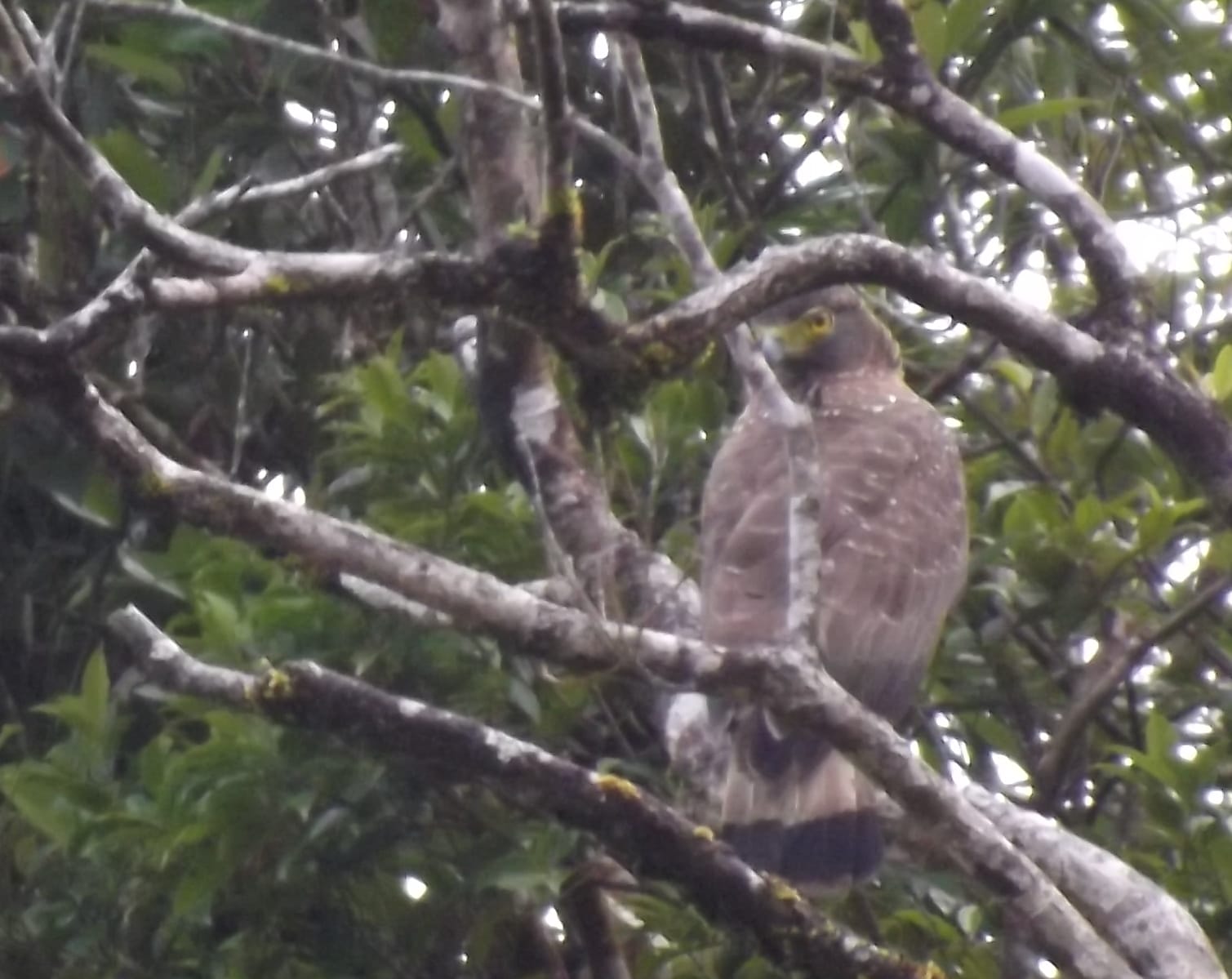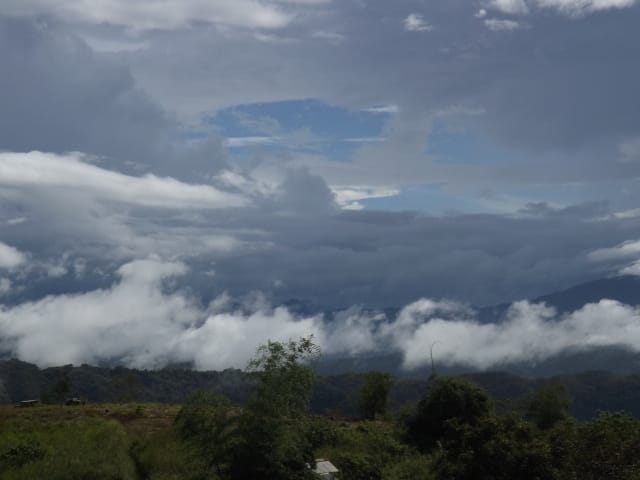by Linda Gocon
Amazing things can happen when you put your mind to it! You can overcome all sorts of obstacles that threaten to get in the way of your goals. Linda Gocon doesn’t let typhoons, sick children, or even a lack of raptor watching buddies keep her from keeping her watch at Tanay!
“Even the smallest person can change the course of the future,” J.R.R. Tolkien in The Fellowship of the Rings. Going raptor watching by myself has never been a personal desire or goal of mine. In fact, raptor watching in itself was never an interest of mine until we moved to Taytay, Rizal in 2012 and I joined one of the raptor watching trips at the Pagasa station in Tanay, Rizal with Alex Tiongco and Tere Cervero. That first experience was not very exciting nor productive. We were a fairly large group but most of us were relying on our naked eyes to spot the raptors. Disappointed in not seeing much, some left and were discouraged in ever going back. It was that day, though, that Randy Weisser talked about trying to find the “shining path”, a road which we could see on the ridge opposite to us east of the Pagasa Tower. He wondered if he might see more raptors from that point of view, so he went and found it. It’s that sort of self-initiative which motivated me to go and look for raptors, too.
Not long after, I decided to drive to Infanta, Quezon on my own to see if I could spot any raptors. When I reached Sta. Maria, Laguna, I stopped and asked a lady standing in front of her house if she ever saw raptors flying through that area. She responded with a resounding yes and said they see hundreds flying through the valley. That was new information for the knowledge base and confirmation that they fly through the valley. I didn’t see any raptors flying through the valley but I did spot a Philippine Serpent Eagle perched on a branch and a perched Sparrowhawk. A large raptor was also flying around which was probably an Oriental Honey Buzzard or the Rufous-bellied Eagle.

The first time I saw a kettle, or a flock of raptors, I was hooked. By then, those of us who were committed to raptor watching had all learned that we had to constantly use our binoculars to scan the skies because unless they fly close to the tower, you cannot see them with the naked eye. And even with binoculars, it is hard to see them if they are really far away. They’re just little black dots off on the horizon, making you think you’re seeing Swiftlets or White-breasted Wood Swallows instead of raptors. The raptors usually begin coming up from down in the valley and begin circling like a tornado, forming a bigger and bigger kettle and rising higher and higher until they are way up in the sky. And then they hit a thermal and begin flying off, almost in single file, disappearing in a matter of seconds. It’s a spectacular show. The easiest time to count them is when they fly off. Trying to count raptors thermalling will only frustrate you as they crisscross each other and you run the risk of recounting the same ones.

This Autumn, 2015 my obsession with raptor watching rose to new heights while my husband and I were on a missions trip to Batanes from October 5-8. On our last day, while I was birding the streets of Basco, two tricycle drivers from the southern port town of Ivana informed me that just the day before, on October 6th, they had spotted raptors arriving by the hundreds. They said the raptors arrived around 5 pm and roosted there for the night. Knowing they must be Grey-faced Buzzards because they begin migrating from Japan in late September and early October, I hired one of the men, Pong Javier, to take me and my husband there. We arrived in Ivana just at sunset. As I looked through my binos, I caught sight of a huge kettle and counted 250 Grey-faced Buzzards! They were thermalling just off the shoreline. Most flew on south to Sabtang Island but some stayed and roosted in the trees up on the ridge overlooking the port. What a thrill to learn that Ivana was part of the flyway to Luzon! Pong told us that October 12 is the date the locals know as the peak for the Kuyab, the Ivatan name for the GFB. Interestingly, he said they never see them during the Spring migration, only in October.
After returning home, I was anxious to go to Tanay and see if any of the GFB’s were arriving. First, though, I researched and found a Facebook page for the Raptor Research Group of Taiwan. They have people going up every day in September and October to count raptors in Kenting at the southern tip of Taiwan and they keep the records on a spreadsheet. Looking at their report, only a handful of GFB’s were spotted the first week of October, indicating that the GFB’s in Ivana were coming down a different path through Taiwan. What a revelation to us all! Meanwhile, Pong was texting me nearly every day reporting that thousands were flying through Ivana between 3 and 5 pm. On October 14, he reported that it was already dark and they were still arriving.
I work at our children’s school and I help my husband in his missionary work so I cannot get away easily. But, I was all caught up on work so I hatched a plan to go out on Tuesday, October 13 after working for an hour. Unfortunately, my 14-year old son got sick at school so I had to take him home. Knowing he would just sleep all day, I felt no qualms in leaving him at home and I proceeded to go to Tanay. Arriving at 10:20 am, I immediately saw two raptors which looked like Grey-faced Buzzards but I couldn’t be sure because they had already passed the tower. That’s all I saw in the two hours I was there and I left at 12:30 to get back to school to pick up our other son.
I played hooky again from work on Wednesday, October 14, arriving in Tanay at 9:00 am. Only 8 raptors made a showing, half of them looking to be Grey-faced Buzzards. Knowing that Typhoon Lando was heading our way, I got away again from work on Friday, October 16 and arrived in Tanay at 8:00 am. The first raptor arrived at 8:05 am, a GFB and a few minutes later I spotted a big kettle of 77, all GFB’s. The next group had 90 and from then on it was a steady stream of small to medium sized kettles until 10:30 am. Jackpot! It was then, though, I began to see the cons of raptor watching alone. For one thing, you can’t take any breaks, not even to go down and use the rest room. If you do, you might miss seeing a kettle. Also, having someone else with you gives another pair of eyes to spot the raptors. And, one of you can record while the other counts. Lastly, it is always more fun to have someone you can enjoy the event with. It’s not much fun dancing around on the terrace alone, rejoicing that you just saw a kettle of 55 GFB’s go through.

The next day, Saturday, October 15, with the typhoon just hours away from making landfall, Mabel and James Hutchison went out with me, their first time to raptor watch. The winds were whipping around us, it was dark, raining and visibility was low. Our hands were freezing and stiff. We stuck it out until 11:00 and then called it a day, without seeing a single raptor. They loved it, though, and want to return. As Patty Adversario said the first time she went out with me and we were surrounded by fog, wind and rain, “Spending a day in good company and being out in nature, no matter what the conditions are, makes it all worth it.”


Contact number for Pong Javier in Batan: 0908-347-1224.
Link to the Raptor Research Group of Taiwan’s spreadsheet: https://goo.gl/xtyrHY

I just bet I’d find raptor watching an exercise in frustration, too. But I’ll try it once and see if maybe I can get hooked, too.